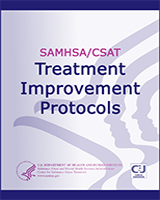NCBI Bookshelf. A service of the National Library of Medicine, National Institutes of Health.
This TIP, Substance Abuse: Administrative Issues in Outpatient Treatment, was written to help administrators work in the changing environment in which outpatient treatment programs operate. The TIP provides basic information about running an outpatient treatment program, including strategic planning, working with a board of directors, relationships with strategic partners, hiring and retaining employees, staff supervision, continuing education and training, performance improvement, outcomes monitoring, and promotion of the program to potential clients, funding agencies, and government officials. More specialized sections address challenges that have emerged and gathered importance in the last decade: preparing a program to provide culturally competent treatment to an increasingly diverse client population, succeeding in a managed care-dominated world by diversifying the funding sources a program draws on, and understanding privacy and confidentiality requirements imposed by Federal legislation.
Contents
- Acknowledgments
- What Is a TIP?
- Consensus Panel
- KAP Expert Panel and Federal Government Participants
- Foreword
- Executive Summary
- Chapter 1. Introduction
- Chapter 2. Management Issues
- Roles of the Program Executive
- Strategic Planning and Implementation
- Board of Directors
- Program Policy and Procedure Management
- Relationships With Strategic Partners
- Referring Clients to Services Outside the Program
- Sharing New Knowledge With Those in the Field
- Management and Administrative Issues
- Program Visibility: Outreach and Public Relations
- Chapter 3. Managing Human Resources
- Chapter 4. Preparing a Program To Treat Diverse Clients
- Understanding Cultural Competence
- Learning About Cultural Competence in Organizations
- Preparing for Cultural Competence Assessment
- Understanding the Stages of Cultural Competence
- Performing Cultural Competence Assessment
- Implementing Changes Based on Cultural Competence Assessment
- Developing a Long-Term, Ongoing Cultural Competence Process
- Undertaking Program Planning
- Appendix 4-A. Cultural Competence Resources
- Appendix 4-B. Community Diversity Form
- Chapter 5. Outpatient Treatment Financing Options and Strategies
- Planning and Developing a Program
- Funding Streams and Other Resources in the Substance Abuse Treatment Environment
- Working in Today's Managed Care Environment
- Contracts Are Primary Tools in Managed Care
- Elements of Financial Risk in Managed Care Contracts
- Networks, Accreditation, and Credentialing
- Organizational Performance Management
- Utilization and Case Management
- Strengthening the Financial Base and Market Position of a Program
- Preparing for the Future
- Chapter 6. Performance Improvement and Outcomes Monitoring
- Increasing Importance of Outcomes Measures in Today's Funding Environment
- Improving Performance and Monitoring Outcomes
- Measuring Performance and Outcomes
- Outcomes Measuring Instruments
- Program Monitoring for Special Purposes
- Working With Staff on Performance and Outcomes Improvement
- Costs and Funding of Outcomes Improvement
- Using Performance Data To Promote the Program
- Appendix 6-A. Satisfaction Form for Clients
- Appendix 6-B. Satisfaction Form for Referral Sources
- Appendix A—Bibliography
- Appendix B—Resource Panel
- Appendix C—Cultural Competency and Diversity Network Participants
- Appendix D—Field Reviewers
This publication was produced by JBS International, Inc. (JBS), under the Knowledge Application Program (KAP) contract numbers 270-99-7072 and 270-04-7049 with the Substance Abuse and Mental Health Services Administration (SAMHSA), U.S. Department of Health and Human Services (DHHS).
Suggested citation:
Center for Substance Abuse Treatment. Substance Abuse: Administrative Issues in Outpatient Treatment. Treatment Improvement Protocol (TIP) Series 46. DHHS Publication No. (SMA) 06-4151. Rockville, MD: Substance Abuse and Mental Health Services Administration, 2006.
The opinions expressed herein are the views of the consensus panel members and do not necessarily reflect the official position of CSAT, SAMHSA, or DHHS. No official support of or endorsement by CSAT, SAMHSA, or DHHS for these opinions or for particular instruments, software, or resources described in this document is intended or should be inferred. The guidelines in this document should not be considered substitutes for individualized client care and treatment decisions.
- NLM CatalogRelated NLM Catalog Entries
- Administrative challenges to working with HIV-positive clients: experiences of mental health and substance abuse program directors in Florida.[J Ment Health Adm. 1989]Administrative challenges to working with HIV-positive clients: experiences of mental health and substance abuse program directors in Florida.Dow MG, Knox MD, Cotton DA. J Ment Health Adm. 1989 Fall; 16(2):80-90.
- The provision of public-sector services by family planning agencies in 1995.[Fam Plann Perspect. 1997]The provision of public-sector services by family planning agencies in 1995.Frost JJ, Bolzan M. Fam Plann Perspect. 1997 Jan-Feb; 29(1):6-14.
- Program directors' views of the effect of managed care on substance abuse programs in Los Angeles county.[Psychiatr Serv. 1998]Program directors' views of the effect of managed care on substance abuse programs in Los Angeles county.McNeese-Smith DK. Psychiatr Serv. 1998 Oct; 49(10):1323-9.
- Review Population risk factors and trends in health care and public policy.[J Acad Nutr Diet. 2012]Review Population risk factors and trends in health care and public policy.Haughton B, Stang J. J Acad Nutr Diet. 2012 Mar; 112(3 Suppl):S35-46.
- Review The study of client-provider interactions: a review of methodological issues.[Stud Fam Plann. 1994]Review The study of client-provider interactions: a review of methodological issues.Simmons R, Elias C. Stud Fam Plann. 1994 Jan-Feb; 25(1):1-17.
- Substance Abuse: Administrative Issues in Outpatient TreatmentSubstance Abuse: Administrative Issues in Outpatient Treatment
Your browsing activity is empty.
Activity recording is turned off.
See more...
